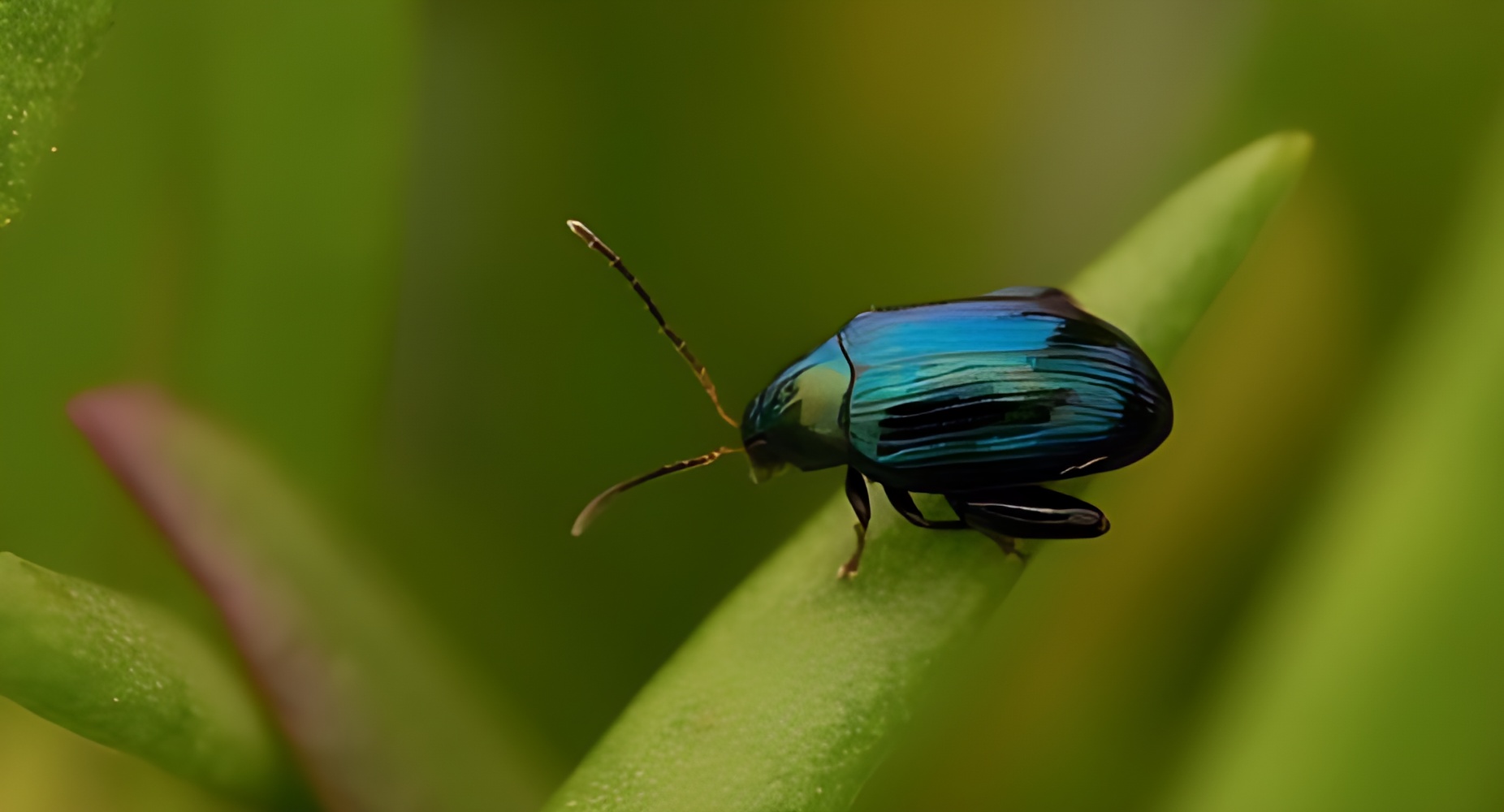How to Get Rid of Flea Beetles in Your Garden
Ignoring the inconspicuous yet menacing presence of flea beetles in your garden could prove catastrophic. These diminutive insects wield immense power to wreak havoc, inducing a realm of repercussions: from stunted plant growth to the deformity of leaves and their eventual withering. Their voracious appetite for nibbling through foliage is only part of the story; the insidious spread of plant diseases looms large in their wake. Vulnerable fledgling plants face a dire fate, potentially succumbing to the fatal assault.
By preemptively acquainting oneself with the telltale signs of infestation, a trifecta of time, labor, and resources stands to be salvaged, sparing you from the relentless pursuit of these garden marauders.
What are flea beetles?
Flea beetles, named for their minute stature and erratic movement patterns, present a peculiar spectacle in the garden landscape. When provoked, these insects execute swift evasive maneuvers, propelling themselves away using elongated hind legs, mimicking the agility of their eponymous counterpart. Their diminutive size, rarely exceeding 1/8 inch, coupled with their rapid locomotion, renders their detection a formidable challenge.
An assorted array of flea beetle species exists, exhibiting a kaleidoscope of hues. Predominantly ranging from subdued tan to somber black, some flaunt vivid pigmentation, while a select few boast ornate striped or spotted exoskeletons.
Wintering amidst garden detritus, adult flea beetles emerge with the advent of early spring, spurred by temperatures cresting around 50ºF. Post procreation, these beetles deposit their eggs encircling the nascent plants. The juvenile cohort often targets plant roots for sustenance, whereas their adult counterparts engage in a voracious leaf-munching spree, pockmarking foliage with perforations.
Flea Beetle Life Cycle
The intricate life cycle of flea beetles involves a dual existence, encompassing both larval and adult phases, each inflicting distinct havoc upon plants. This life trajectory, albeit slightly variable among species, unfolds as follows:
- As autumn wanes, adult beetles delve into the garden’s soil or seek refuge in foliage and debris, initiating their hibernation phase. Certain types might retreat to wooded realms for repose.
- Spring heralds their reanimation, coinciding with a surge in outdoor temperatures approximating 50ºF. This juncture marks the zenith of devastation, particularly impactful as it coincides with the emergence of vulnerable young plants, succumbing most severely to their voracious leaf-gobbling proclivities.
- Amidst summer’s embrace, these awakened adults lay the foundational eggs for the forthcoming generation, strategically depositing them at the base of plant stems.
- Upon hatching, the ravenous larvae embark on a 2 to 3-week feast, devouring the precious roots of host plants.
- Following a brief pupal interlude of approximately one week, they metamorphose into adults, initiating a fresh cycle of leaf consumption. This subsequent generation exacts the most significant toll on fall crops before seeking hibernation sanctuaries once more.
How to Identify Flea Beetles
Diverse in their multitude of species, flea beetles exhibit a kaleidoscope of appearances. Shades oscillate between the somber hues of black and tan, punctuated by vivid splashes of brighter tones. Their external veneer may showcase an array of patterns—be it solid, striped, or speckled—varying according to the specific species.
Spotting these diminutive creatures proves challenging, given their minuscule 1/16-inch length and their propensity to swiftly evade detection, akin to the agility of fleas, upon sensing human proximity. Thus, discerning signs of their inflicted damage stands as a more pragmatic method to identify their presence, eclipsing the difficulty of spotting the beetles themselves.
What do flea beetles eat?
Various flea beetle types exhibit dietary preferences, with some being generalists, ravaging a diverse plant array, while others are specialists, fixating solely on specific plant species.
Within the garden domain, brassica clan members—broccoli, cauliflower, kale—fall prey to flea beetle predation. Nightshade plant foliage, encompassing tomatoes, peppers, and eggplants, entices these pests. Additionally, crops such as squash, corn, and lettuce fall within their grazing purview. Even certain weeds captivate flea beetles, accentuating the necessity of vigilant weed control to thwart their attraction.
Symptoms of a Flea Beetle Infestation
Adult flea beetles inflict foliage damage, punctuating leaves with telltale “shotholes.” Vigilance is crucial, especially for tender seedlings, as swift deterioration occurs here. These round perforations, akin to Swiss cheese, swiftly mar leafy greens, primarily targeting nascent foliage, rendering it a lace-like semblance.
Mature plants withstand their assault, as their expansive leaves endure a few breaches. However, the peril lies in bacterial disease dissemination—wilt and blight—transmitted by these beetles. Leafy crops, like lettuce or spinach, witness compromised quality due to these holes. Despite their limited fatal impact on established plants, flea beetles remain pivotal, posing a dual threat by both physical damage and bacterial contagion, warranting vigilant pest management.
What does flea beetle damage look like?

Detecting the fleet-footed flea beetles amidst your garden proves arduous due to their minute size and rapid movements. Identification often hinges more on the aftermath they leave behind rather than spotting the elusive bugs themselves.
The larvae’s root-nibbling tendencies typically yield minimal harm, occasionally stunting seedling growth. Conversely, adult flea beetles emerge as formidable adversaries. Their nibbling ritual unleashes a patchwork of mottled leaf surfaces, punctuated by an intricate tapestry of minuscule pits and holes.
Spring serves as their peak season, magnetizing these insects toward tender, nascent leaves, rendering seedlings exceptionally susceptible. Established plants withstand their onslaught, yet leafy greens suffer aesthetic depreciation. However, the underlying menace lies in their potential to disseminate prevalent plant ailments—blights and wilts—inflicting catastrophic consequences upon crops. Identifying their residual damage remains pivotal for proactive pest management.
How to Get Rid of Flea Beetles
- Craft a homemade remedy to combat flea beetles: Blend 2 cups of isopropyl alcohol, 5 cups of water, and 1 tablespoon of liquid soap. Preliminary leaf application, followed by overnight observation, determines safety; if no adverse effects surface, proceed to spray the entire plant. Apply this mixture onto vulnerable garden foliage.
- Shield tomatoes, potatoes, and peppers from flea beetles by dusting leaves with plain talcum powder, deterring their infestation.
- Employ white sticky traps, strategically positioned to ensnare these agile jumpers, curtailing flea beetle proliferation.
- Exercise caution with insecticides, primarily at season commencement, although their necessity diminishes for adult plants. Vigilance amplifies when grappling with soil predisposed to bacterial diseases. For tailored guidance, liaise with your local nursery or cooperative extension.
Tips for Preventing Flea Beetles
Maintaining supremacy over flea beetles and garden nuisances hinges on astute garden upkeep and strategic planting tactics.
- Post previous flea beetle invasions, cleanse your garden of any residual afflicted plant remnants before replanting. Consider soil tilling if the infestation is severe.
- Deploy floating row covers early on to shield your garden from flea beetles and their cohorts.
- Delay spring seedling and seed planting by a few weeks, strategically depriving flea beetles of sustenance, safeguarding nascent plants.
- Employ companion planting as a natural deterrent. Aromatic varieties like catnip and green onions repel flea beetles, fortifying neighboring plants.
- Foster beneficial insect populations by cultivating flowering plants like dill and sweet alyssum near vulnerable vegetables, luring insects that prey on flea beetles.
- Employ trap crops such as radishes to divert flea beetles from valuable produce, safeguarding leafy greens against their ravages. Strategic planting and proactive measures fortify your garden’s defense against these persistent pests.
Frequently Asked Questions (FAQs):
What are flea beetles, and how do they damage garden plants?
Flea beetles are diminutive insects that inflict damage on garden plants by nibbling on foliage. They create small round holes known as “shotholes” in leaves, imparting a lace-like appearance. These beetles target young plants, causing stunted growth and significant harm, especially during spring. While mature plants can endure some damage, the real threat lies in their ability to transmit bacterial diseases, such as wilts and blights, from plant to plant. This damage, coupled with their rapid movement and minuscule size, makes flea beetles a persistent threat to garden vegetation, necessitating proactive pest management strategies.
What is the most effective long-term strategy for managing flea beetle populations?
Employing diverse tactics forms the most effective long-term strategy for managing flea beetle populations. Implementing good garden hygiene by clearing infected debris, utilizing row covers to shield plants, and companion planting with repellent herbs like catnip and onions aids in deterring flea beetles. Delaying planting to disrupt their lifecycle and fostering beneficial insect habitats with flowering plants like sweet alyssum contribute to population control. Additionally, employing trap crops such as radishes diverts beetles from main crops. A holistic approach encompassing preventive measures and natural deterrents stands as an effective long-term strategy against these persistent garden pests.
How can I prevent flea beetles from returning to my garden each season?
Preventing recurring flea beetle infestations involves several strategies. Clear garden debris to eliminate overwintering sites, and till the soil to disrupt their lifecycle. Implement floating row covers early in the season as a physical barrier. Delay planting to deprive emerging beetles of susceptible plants. Practice companion planting with repellent herbs like catnip or onions. Encourage beneficial insects by cultivating flowering plants nearby. Employ trap crops such as radishes to lure and divert flea beetles. Rotating crops and maintaining good garden hygiene stand as effective methods to prevent their annual return, safeguarding your garden from persistent flea beetle invasions.

